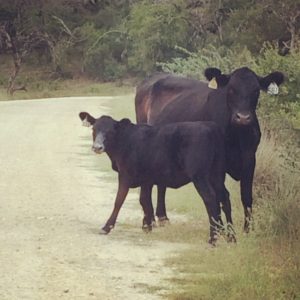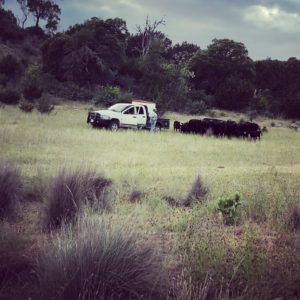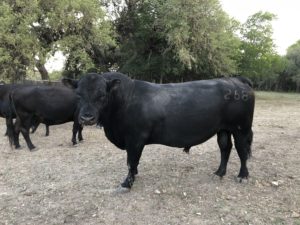In 1887, Alfred Giles purchased three Aberdeen Angus cows from Scotland. The land reminded him of where he and his family had vacationed in Scotland, and he remembered the black cows on the green hills; he wanted his own.
By most standards, our cattle are small. Cows average about 1,100 pounds. We believe it is important to have an animal that can live off of the land. Larger cows couldn’t get enough to eat to survive here.
Our cattle are supplemented with protein during the winter months. Hay is never fed. If we feel like our cattle need hay, then we have too many cattle and find other country for them.
Calving
Our cows begin calving in late February through early April. At about four months of age, our calves are worked. This includes vaccinating, ear tagging, treating for internal and external parasites, and castrating most bull calves. Cows and bulls also receive a round of vaccinations at this time.

Weaning & Winter Grazing
Calves are weaned beginning in October.
In mid-November, our calves are then shipped to the Samuel Roberts Noble Foundation in Ardmore, Oklahoma. The Noble Foundation is an independent, non-profit institute that conducts research to enhance agricultural productivity and profit.
The calves spend the next 5-6 months grazing different plant varieties that are being tested for grazing as well as bio-fuel potential. Once the grazing trial is complete, selected heifer calves are shipped back to the ranch. The decision is then made whether to sell the steers and remaining heifers at auction or to retain ownership through the feedlot stage.

Bulls
Some bull calves are selected to be kept as bulls for our own breeding purposes or to be sold, while others are castrated. Since the calves are so young and there are no records other than dam and sire, eye appeal is the greatest factor that goes into selecting ‘keeper’ bulls.
Bull calves are then placed on a gain test here at the ranch. They are on feed for 110 days. Each bull is weighed before going on feed and is again weighed after the 110 days is complete. This year’s ration consists of ground milo (carbohydrate concentrate), cottonseed meal (protein concentrate), cotton gin trash (roughage), as well as trace minerals and antibiotics.
This feeding period is a chance to collect data on efficiency and production to be considered in genetic selection of future herd sires. Basically, what we are measuring is feed conversion. The term feed conversion is simply the amount of feed an animal consumes as compared to the amount of body weight gained, expressed as a ratio. Feed conversion ratios around 6:1 (6 pounds of feed per pound of gain) are common in most beef cattle operations. Cattle that gain more weight with less feed or forage are more efficient.
Our bulls are given a bull breeding soundness examination, ensuring they are fertile and able to reproduce. Bulls are available for sale each year.

Advances in Technology
Ultrasounding bulls has become an extremely useful tool for us. Ultrasounding an animal allows us to put a score of muscling by weight, which would be difficult by visual observation alone.
As each bull is scanned, we are able to see a cross section between the 12th and 13th rib on a screen. The results are then sent to us, including rib eye area and rib eye fat, for each animal. With this information we can compare each animal with a ratio of square inches of rib eye muscle per 100 pounds of animal. This data is extremely useful to us when selecting which animals to keep and which to sell.
Our cattle produce beef ranked as prime or choice 95% of the time.
